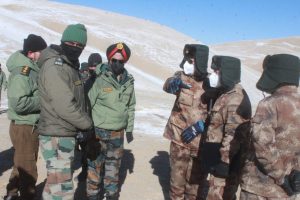Almost 10 months after the standoff between the India and China erupted along the Line of Actual Control (LAC) in eastern Ladakh, troops and military hardware have been withdrawn from both the banks of Pangong Lake, key flashpoints during the crisis.
Both neighbors announced an agreement for disengagement on February 11 that will bring to an end their forward deployments in the contested zone. Indian Defense Minister Rajnath Singh was quoted by the media as saying that the disengagement would “substantially” restore the situation to that existing prior to the confrontation last year.
The agreement entails withdrawal of Chinese troops on the north bank to east of Finger 8 while the Indian side will move to their permanent base at Dhan Singh Thapa Post near Finger 3. Structures that were built after April 2020 are to be removed with the restoration of the landforms. There is also a freeze on patrolling in the zone until a resumption is agreed upon by both the sides.
In April last year, China assembled a large number of troops in eastern Ladakh and other areas along the 3,488-kilometer-long LAC, triggering skirmishes at Galwan Valley, Pangong Lake, Gogra-Hot Springs and other areas. The status quo was changed after the People’s Liberation Army (PLA) built fortified structures in what was perceived by India as its territory.
On May 5, a clash erupted when the PLA moved up to Finger 4 from Finger 8 resulting in injuries to over 70 Indian soldiers, which was followed by reports of another conflict at Naku La in Sikkim. India responded by deploying troops to match the Chinese build-up.
Subsequently, India and China reached an understanding for phased disengagement which was to be followed by de-escalation along the LAC with both thinning troops and weapons from their respective sides of the LAC. The clash on June 15, when 20 Indian and at least four Chinese soldiers reportedly died, broke out during the initial process of disengagement in the Galwan Valley.
Despite the clash, disengagement continued in the Hot Springs area and on the north bank of Pangong Lake with the objective of creating a buffer zone at these locations. But tensions occurred again in the end of August when the Indian army blocked Chinese attempts to advance on the south bank of the lake and occupied a few peaks of the Kailash range, triggering fresh deployments of troops and tanks again by both the sides stalling the earlier agreed-to disengagement process.
Negotiations for disengagement continued and a consensus for “synchronized and organized disengagement” on the southern and northern shores of Pangong Lake was reached on January 24. The agreement was announced almost three weeks later, first by China’s Defense Ministry.








































